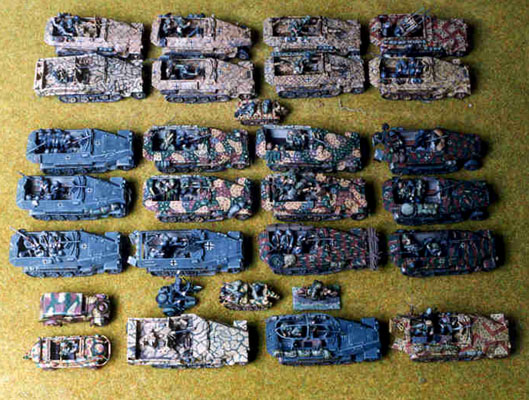When I was slightly younger and comparatively ignorant, I thought that it would be a good idea to make up a load of 251 Hanomag half-tracks, so that I could wargame with them. My simple idea was to have enough to field an entire infantry company. This seemed easy enough. Each Hanomag half-track could carry a section, so three could carry a platoon of three sections, and so nine could carry a company of three platoons. I bought up a load of the Matchbox 1/76th scale kits and started modelling. I might have been a happy person, content with my little project, had I not suffered from the ghastly flaw of feeling that a bit of research might be good.
I soon discovered that each platoon had a command vehicle, which was different, as it had a 37mm anti-tank gun on it instead of the front machine gun. No matter, thought I, and I converted one Matchbox kit, and got hold of two Fujimi kits of the same scale, which had the 37mm AT gun as an optional few parts. If only I could have let things lie. More research revealed so much more.
It turned out that each armoured infantry company had a support platoon. "Blast," thought I, "another four vehicles." If only. The support platoon varied enormously in composition, but typically had two 251/9 Stummels with 75mm guns, two 251/2 mortar carriers, anti-aircraft variants, and extra 251/1 passenger vehicles for such things as sustained-fire machine gun and panzerschreck teams. Even more, the company as a whole had a command platoon, with radio vehicles, and more AA vehicles. I kept going back to my local model shop for "Just a couple more Hanomags, to finish off my company."
Worse still, the Matchbox and Fujimi kits are of the Mark B version of the vehicle. The Mark A versions were the best looking, with extra view ports down the side, but these ceased production right at the start of the war. The Bs were good-looking. The C versions were slightly uglier, but many of the later variants, such as the 251/9 Stummel, used this version of the basic vehicle. Later still, was the Mark D which was very ugly and very different-looking. To make such specialist converted vehicles, I would need first to convert the Matchbox kits into Mark Cs or Ds and then convert these into the various variants.
Be warned, therefore, of the dangers of research.
Alle zusammen. The back row is the heavy weapons support platoon, left to right: three AA vehicles (251/17 with unarmoured open back, then 251/17, then 251/21); the platoon's 251/1 command vehicle; a Kettenkrad half-track motorcycle (by Hasegawa) for the platoon's messenger rider; two 251/9 stump guns; two 251/2 mortar carriers.
The middle of the picture has the panzergrenadier infantry vehicles of the three platoons, each with three 251/1s, and one 251/10. Each platoon is painted with a different camouflage scheme, which makes things clearer for wargaming purposes. The left hand platoon is in "ambush" scheme, and the centre one is in panzer grey (making it suitable for games set in 1940).
The front row is the command platoon. Left to right: a motorcycle with side-car (would normally be a simple motorcycle, but they used whatever they had); a VW 166 Schwimmwagen (might just be an ordinary Kuebelwagen, but who wants to be ordinary?); a VW 82 Kuebelwagen (officer's personal transport, not for front line battle use); the two 251/3 command radio vehicles; one 251/17 AA vehicle; a Kettenkrad, and a motorcycle with rider (both SHQ). The motorcycle, unlike the rest of the vehicles, is mounted on a base to help it stand up, which alas also makes it a bit difficult to see.
For some reason, I have photographed the 251/21 with the support platoon, and one of the two 251/17s with the command platoon. The vehicles might well have been assigned this way, but the 251/17 models are all in the camouflage scheme of the support platoon, and the 251/21 is in the same camouflage scheme as the late-model 251/3 radio vehicle, so really should have been shown at the front. No matter.
Now pick and click:
Thanks to the members of the Crossfire and Spearhead mailing list for help with my research, most notably Ingolfur Bjorgvinsson of Iceland, Greg Huffa of New Zealand, and Hauke Kueck of Germany.
You may like to visit the Hanomag 251 Website.

BACK TO WW2 VEHICLES MENU BACK TO MODELLING MENU
Click here to go back to the home page





